What are the Famous Spring & Autumn Treks in Uttarakhand
Published: 21 Aug 2025
I walked through Uttarakhand’s trails in every season but spring and autumn always feel the most magical to me. In March and April, the valleys wake up with bright rosebay, fresh meadows and the last bits of snow melting under the sun. The air feels soft and every step shows me something alive and colorful.
Then comes October and November, when the monsoon clouds clear out and suddenly the mountains look sharper, the skies turn crystal blue and the forests glow with golden leaves. Trekking in autumn feels peaceful, almost like the Himalayas are standing still just for me to admire them.
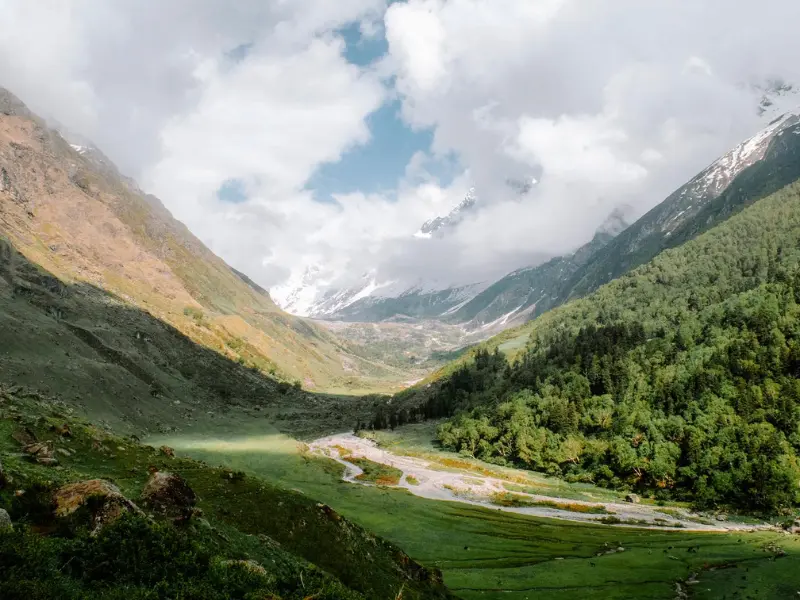
In this guide, I am sharing my favorite spring treks in Uttarakhand (March–April) and autumn treks in Uttarakhand (October–November) along with planning tips, safety advice and little moments that make each route unforgettable.
Why I Love Trekking in Spring & Autumn in Uttarakhand
Every season in Uttarakhand feels special but when I trek in spring and autumn, the trails feel alive in a way that’s hard to put into words.
Spring Treks (March–April)
When I walk through the forests in March and April, I see rhododendrons (locals call them buransh flowers) painting the hills in bright red and pink. The snow from winter is still melting, so I often find little streams crossing my path. The air is cool but gentle and it feels like the mountains are stretching after a long sleep. Spring treks are perfect for people who want to enjoy colors, fresh greenery and mild weather.
Autumn Treks (October–November)
Autumn feels completely different. By October, the rains are gone and the skies open up like crystal glass. I remember standing on a ridge in Kedarkantha last November and the peaks looked so sharp against the sky that it felt unreal. The forests turn golden, the air is crisp and the views stretch endlessly. Autumn treks are best for those who want clear mountain views, golden forests and stable weather without worrying about rain.
Whenever friends ask me when to trek in Uttarakhand, I always say: Choose spring if you want to walk through colors, choose autumn if you want to gaze at endless peaks. Both seasons are safe, beginner-friendly and breathtaking in their own way.
Best Spring Treks in Uttarakhand (March–April)
Spring in Uttarakhand is when the Himalayan Treks wake up after winter. Trails are filled with rhododendron blossoms, fresh meadows, melting snow and gushing streams. The weather is pleasant during the day but nights can still be chilly. Here are the treks I recommend the most in March and April.
1=> Har Ki Dun Trek
Walking into the Har Ki Dun valley in spring feels like stepping into a hidden Himalayan bowl. The trail passes through pine forests, wooden bridges and charming villages like Osla, where the houses still carry old carvings and local stories. In March, I often find patches of snow along the way but by April the valley opens up with green meadows and streams rushing with melted ice. The beauty here is not just in the mountains but also in the peaceful pace of life.

This trek is known as the “Valley of Gods” and it truly lives up to the name. The towering Swargarohini peaks shine over the valley and the evenings in camp are filled with starry skies that feel endless. It’s a good mix of natural beauty and cultural charm, making it perfect for travelers who want both mountain views and a taste of Garhwal’s village life. Spring adds a soft freshness to the journey and makes every campsite feel magical.
- Best Time in Spring: Mid-March to April, when snow melts and meadows turn green
- Difficulty Level: Easy to Moderate — beginner-friendly with basic fitness
- Highlights: Ancient villages, pine forests, Swargarohini peaks, open meadows
- Tip: Nights can still be very cold in March, so pack warm layers
2=> Chopta Chandrashila Trek
Trekking to Chandrashila in spring is one of my favorite experiences in Uttarakhand. The trail starts from Chopta, often called the “Mini Switzerland of India,” and winds through oak and rhododendron forests that glow with pink and red blossoms in March and April. The climb to Tungnath Temple, the highest Shiva temple in the world, feels spiritual as the temple slowly appears against a backdrop of melting snow.
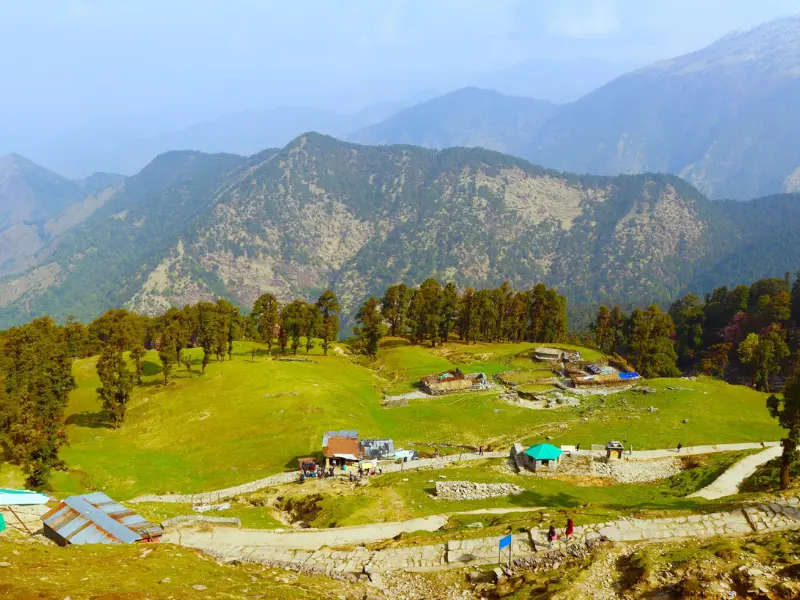
From Tungnath, the final stretch to Chandrashila is steep but rewarding. Standing at the summit at sunrise, I have seen the sky turn golden over Nanda Devi, Trishul and Chaukhamba peaks, a view that never leaves your memory. Spring adds a special touch with forests alive in color and trails become less slippery compared to winter. This trek is short but packed with beauty, making it ideal for beginners and families.
- Best Time in Spring: March–April for flowers and clear skies
- Difficulty Level: Easy to Moderate (short trek but with steep sections)
- Highlights: Tungnath Temple, rhododendron blooms, 360° Himalayan views
- Tip: Begin the summit climb before dawn for the most magical sunrise
3=> Nag Tibba Trek
Nag Tibba is my go-to trek when I need a quick mountain escape. Just two days long, it’s perfect for weekends and doesn’t require much preparation. In March, I often find snow at the top, which adds a thrill, while April brings clearer skies and colorful rhododendrons along the forest trail. The campsites are cozy, with open views of Himalayan ranges like Bandarpoonch and Kedarnath.
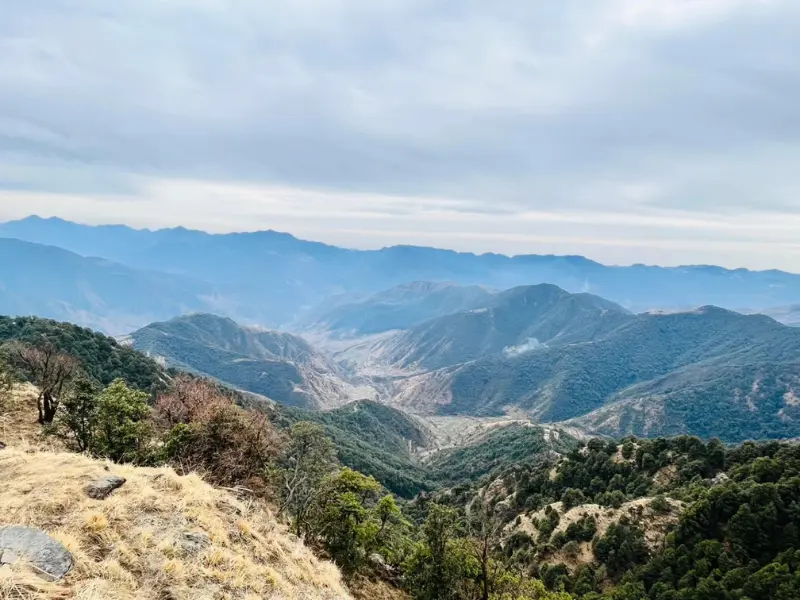
Despite being short, this trek doesn’t compromise on beauty. The forest walk feels refreshing, the summit offers a wide Himalayan panorama and the accessibility makes it one of the best beginner treks near Dehradun. It’s also a favorite for families and first-time trekkers who want to experience a snowy or colorful trail without committing to a week-long journey.
- Best Time in Spring: March for snow, April for flowers and open skies
- Difficulty Level: Easy (suitable for beginners and families)
- Highlights: Oak and rhododendron forests, weekend-friendly, wide summit views
- Tip: Carry a walking stick — it helps on snowy patches in early spring
4=> Kuari Pass Trek
The Kuari Pass trek is often called the Lord Curzon’s Trail and every time I’ve walked it in spring, it has left me in awe. The trek passes through thick forests, wide meadows like Gorson Bugyal and finally opens up to breathtaking views of giant peaks. In March, snow still carpets the trail and by April, the meadows start turning green. These scenes make it a perfect mix of two worlds.
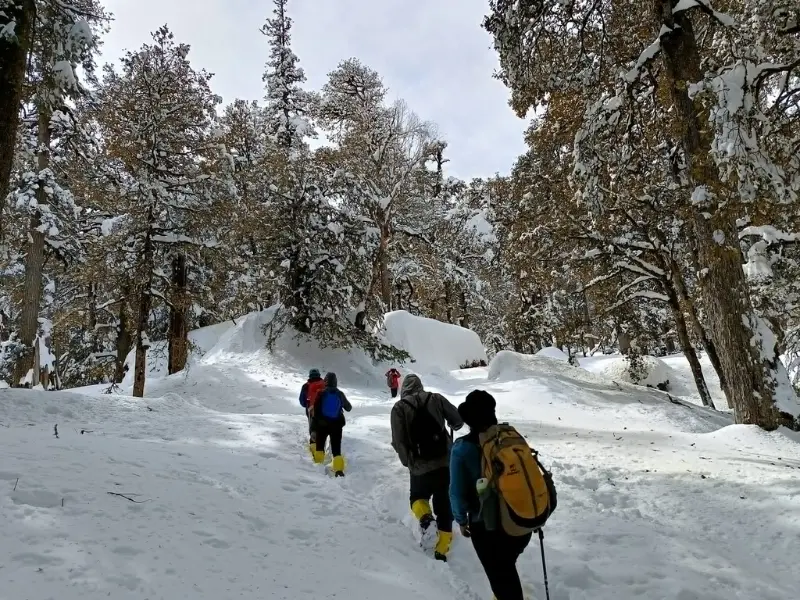
Reaching the pass feels like standing on a grand balcony of the Himalayas. From here, you can see Nanda Devi, Trishul, Kamet and many more peaks shining under the sun. The combination of snow, flowers and endless views makes spring a particularly rewarding time. It’s a bit more challenging than Chopta or Nag Tibba but worth every step for trekkers who want a fuller Himalayan experience.
- Best Time in Spring: Mid-March to late April
- Difficulty Level: Moderate (requires some stamina)
- Highlights: Gorson Bugyal, snow + greenery mix, panoramic Himalayan views
- Tip: Sunglasses are a must — snow glare in March can be very strong
5=> Valley of Flowers (Spring Preview)
Most trekkers visit the Valley of Flowers in monsoon but I’ve also been here in spring and it feels like a secret world just waking up. In April, the snow begins to melt, streams come alive and greenery slowly spreads across the valley. The flowers are not yet in full bloom but the peaceful atmosphere and snow-fed streams make the journey feel serene and raw.
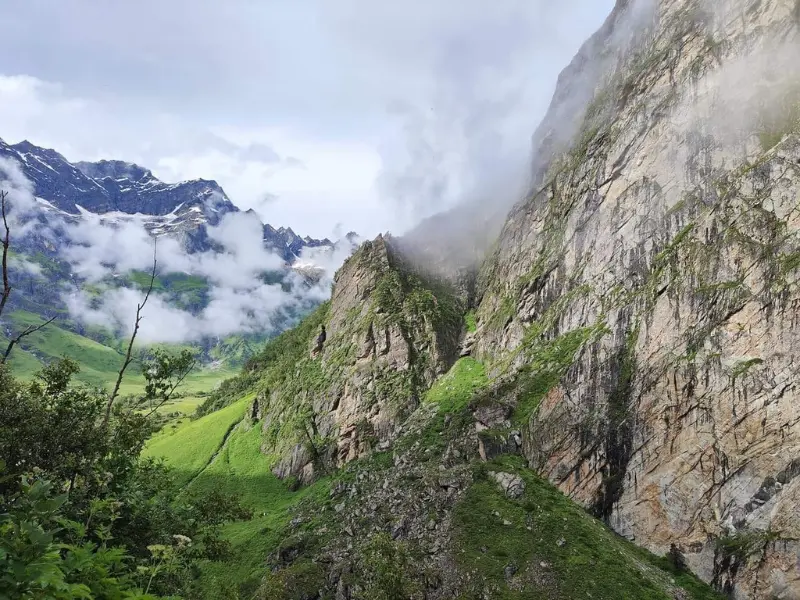
Walking here in spring means fewer crowds and a chance to see the valley in a quieter state. The surrounding peaks glisten with snow and the air feels fresh after winter. While it’s not the colorful flower carpet of July, it’s still worth visiting if you love solitude and watching nature prepare for its grand summer show.
- Best Time in Spring: Late April when snow begins to clear
- Difficulty Level: Moderate (long walking hours, steady climb)
- Highlights: Early greenery, snow-fed streams, peaceful atmosphere
- Tip: Don’t expect full flower bloom — go for solitude and natural freshness
Best Autumn Treks in Uttarakhand (October–November)
Autumn is my favorite season to enjoy clear skies and sharp mountain views. After the monsoon clouds disappear, the Himalayas stand tall in all their glory. The forests turn golden, the air is crisp and every step feels refreshing. Here are some of the best treks I loved exploring in October and November.
1=> Kedarkantha Trek
The Kedarkantha trek feels magical in autumn. In October, the forests are alive with post-monsoon freshness and by November, the peaks start receiving their first snowfall. The trail winds through pine forests, charming clearings and cozy campsites like Juda Ka Talab. Reaching the summit at sunrise is always the highlight — the view of snow peaks glowing in golden light is unforgettable.
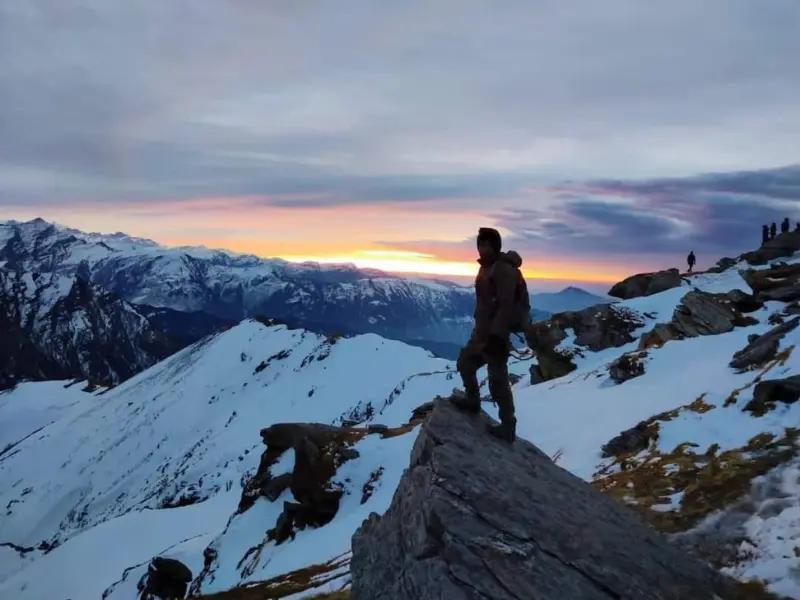
What makes Kedarkantha perfect in autumn is the balance of stable weather and dramatic landscapes. It’s not as crowded as winter, and the trails feel peaceful. The climb is moderately challenging, making it accessible for beginners as well as trekkers who want a taste of snow without harsh conditions.
- Best Time in Autumn: October for clear skies, November for early snow
- Difficulty Level: Easy to Moderate (good first high-altitude trek)
- Highlights: Sunrise from summit, pine forests, Juda Ka Talab lake
- Tip: Carry extra layers in November because temperatures can dip below freezing at night
2=> Dayara Bugyal Trek
Dayara Bugyal is one of the most beautiful meadow treks I have done and in autumn it feels like walking on golden carpets. The meadows stretch endlessly and the post-monsoon greenery slowly gives way to golden-brown tones. From the ridge, you get wide-open views of peaks like Bandarpoonch and Gangotri.
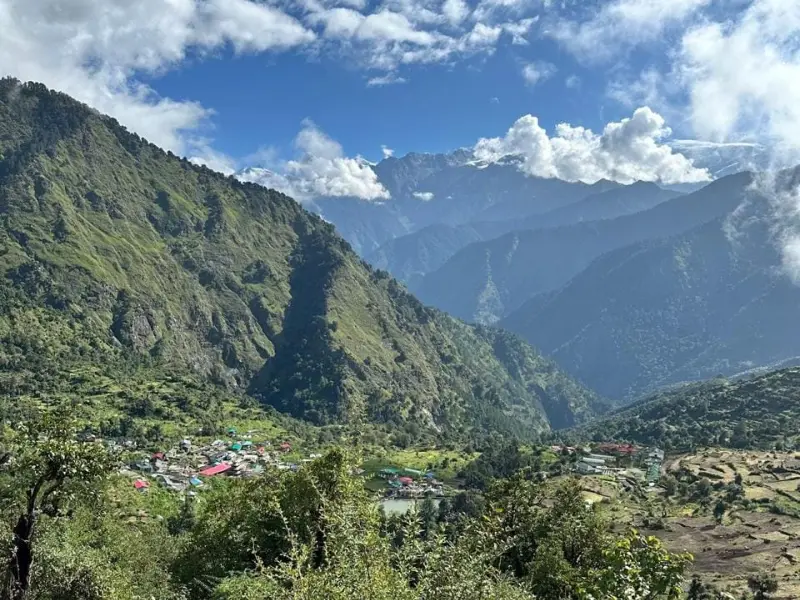
In October, the weather is calm and the skies are crystal clear which makes the views even sharper. The trail is short and beginner-friendly but the rewards feel much bigger than the effort. I love this trek in autumn because the meadows glow at sunset and the evenings feel peaceful and crisp.
- Best Time in Autumn: October–November for golden meadows and clear skies
- Difficulty Level: Easy to Moderate (family and beginner-friendly)
- Highlights: Vast alpine meadows, wide Himalayan views, easy access
- Tip: Even though it’s short, pack thermals as nights can get very cold in November
3=> Brahmatal Trek
Brahmatal is another autumn gem in Uttarakhand. The trail passes through oak and rhododendron forests before opening up to alpine lakes and snow-dusted peaks. By November, the lake reflects the snow-covered mountains, making it one of the most picturesque treks I have ever done.

Autumn also means fewer chances of weather disruptions, so the views remain clear throughout the trek. It’s slightly more challenging than Dayara Bugyal but the combination of forests, lakes and peaks makes every step worth it. I especially love camping under starry skies here and that silence feels unreal.
- Best Time in Autumn: October for greenery, November for early snow near the lake
- Difficulty Level: Moderate (some steep climbs)
- Highlights: Alpine lakes, reflections of Mt. Trishul, golden forests
- Tip: Be prepared for cold winds at campsites and carry windproof layers
4=> Phulara Ridge Trek
Phulara Ridge is unique because you spend hours walking along a high ridge with open views on both sides. In autumn, the ridge feels endless with crystal skies above and rolling valleys below. The trek is less crowded compared to Kedarkantha which makes it even more special.
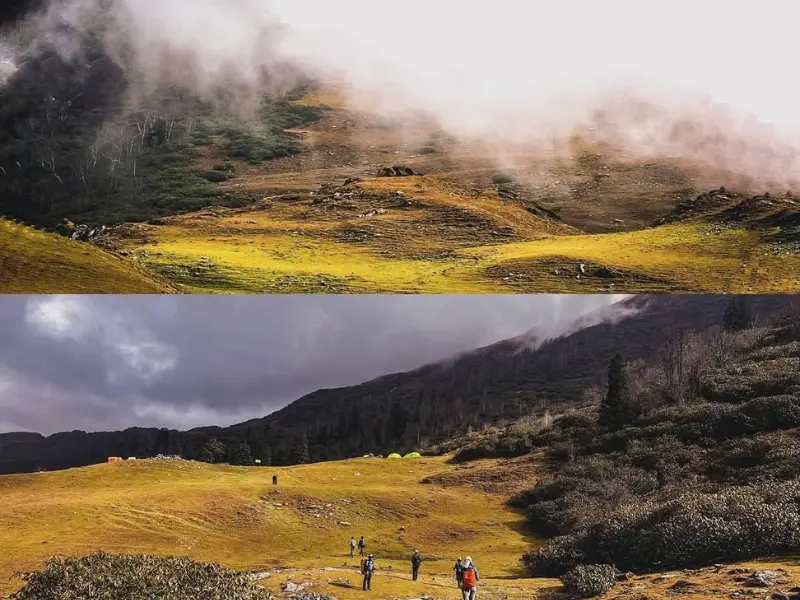
I’ve done this trek in October and the clarity of the Himalayan ranges was breathtaking. The trail mixes forests, meadows and ridge walks which give you a complete trekking experience in just a few days. It’s one of those hidden gems that feel untouched even as more people discover it.
- Best Time in Autumn: October–November for stable weather and views
- Difficulty Level: Moderate (long ridge walk, some stamina needed)
- Highlights: Unique ridge trail, panoramic mountain views, less crowded
- Tip: Carry enough water for the ridge walk, there are fewer refill points along the way
5=> Pindari Glacier Trek
The Pindari Glacier trek is one of the oldest and most popular trails in Kumaon, Uttarakhand. In autumn, the glacier and surrounding peaks shine brilliantly under clear skies. The trail passes through villages, forests and wide valleys before reaching the glacier, making it a culturally rich and adventurous experience.
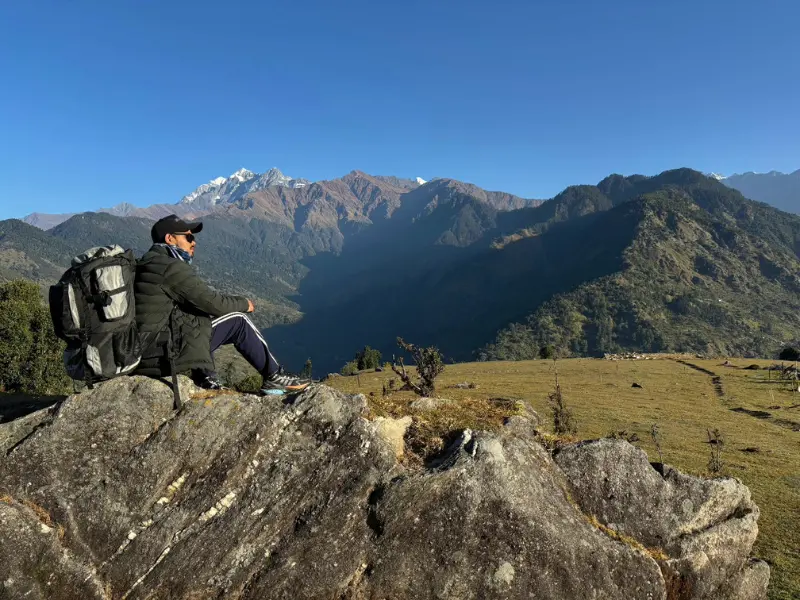
October is the best month for this trek because the weather is stable and the visibility of peaks like Nanda Kot and Maiktoli is superb. The trail is longer compared to other autumn treks but the mix of landscapes keeps it exciting. I always recommend this trek to those who want a taste of adventure beyond meadows and short summits.
- Best Time in Autumn: October for stable weather, early November before heavy snow
- Difficulty Level: Moderate to Difficult (longer trek, requires stamina)
- Highlights: Glacier views, Kumaoni villages, mix of forests and valleys
- Tip: Carry good trekking shoes — the glacier approach can be rocky and uneven
Planning Your Trek: Spring vs Autumn, Packing, Safety & Logistics
Planning is everything in trekking and this is something that sometimes leads to unforgettable memories with safety. Before heading to planning tips, first it is a must to decide which one you should choose, should it be Spring with plenty of flowers or Autumn with golden scenes mixed with snow.
Spring vs Autumn – Which Season to Choose?
I always tell trekkers that spring (March–April) feels like walking through a blooming canvas. The trails are full of flowers, the weather is pleasant and the days are longer for hiking. Autumn (October–November), on the other hand, gives you crystal-clear skies, golden valleys and snow-dusted peaks without the biting winter cold. Both are perfect but it depends on whether you love flowers or crisp mountain views.
Packing Smart for the Season
When I pack for a spring trek, I keep layers light but always carry a rain jacket since the weather can flip quickly. For autumn, I focus on warmer layers because nights can get surprisingly cold in the higher camps. A good pair of trekking shoes, a sturdy backpack and reusable water bottles are always non-negotiable.
Essentials to Pack:
- Spring: Light layers, rain gear, sunscreen.
- Autumn: Thermal layers, woolen caps, gloves.
- All Seasons: Trekking poles, sturdy shoes, medical kit, water purifier.
- Extras: Camera, power bank, torchlight.
Safety First on the Trails
I have seen many trekkers underestimate Uttarakhand treks because of their “easy” tags. Even short routes can become tough if you ignore altitude, hydration or sudden weather changes. I always keep Diamox (for altitude), basic meds and snacks handy. And never trek alone, local guides not only keep you safe but also share wonderful stories about the mountains.
Safety Tips:
- Acclimatize slowly; don’t rush.
- Drink plenty of water and avoid alcohol.
- Follow marked trails; don’t shortcut.
- Always inform someone of your itinerary.
Logistics: Getting In & Around
Reaching most treks in Uttarakhand means starting from Rishikesh, Dehradun, or Kathgodam. I usually take a night bus or train and then hire a shared jeep to the base village. Pre-booking transport during peak spring and autumn saves a lot of hassle. For foreign travelers, Delhi is the main entry point before heading north by road or train.
Travel Logistics:
- Entry Points: Dehradun, Rishikesh, Kathgodam.
- Transport: Shared jeeps, buses, private taxis.
- Stay Options: Guesthouses, homestays, trekker huts.
- Permits: Needed for some treks (book via tour operators or local offices).
Conclusion
Every time I walk the trails of Uttarakhand, I feel the mountains teaching me something new—patience, strength and peace. Whether you choose a flower-filled spring trek or a golden autumn journey, these paths promise more than just views. They give you memories that stay long after the trip ends.
If you are dreaming of clear skies, snowy peaks or the sound of rivers guiding your way, now is the time to plan. Pack smart, stay safe and let the Himalayas surprise you. The mountains are waiting, are you ready to answer their call?
FAQs on Spring & Autumn Treks in Uttarakhand
Here are frequently asked questions:
Some of the best treks are Valley of Flowers, Har ki Dun, Dayara Bugyal and Kedarkantha. These trails offer a mix of meadows, forests and snow peaks which makes them perfect for both beginners and experienced trekkers.
Autumn (October–November) is the clearest trekking season in Uttarakhand. Popular treks include Brahmatal, Roopkund, Kuari Pass and Nag Tibba. You will get golden forests, crystal-clear mountain views and crisp air that makes walking easier.
Both seasons are great but they offer different experiences. Spring treks bring flowers, greenery and mild snow, while autumn treks bring the clearest skies and stunning views of the Himalayas. If you love flowers, choose spring; if you love mountain views, pick autumn.
Pack layered clothing, as temperatures can change quickly. In spring, carry a light jacket, trekking shoes and rain protection. For autumn, pack warmer layers, gloves and a good sleeping bag since nights get colder. Essentials like water bottles, sunscreen and basic medicines are a must in both seasons.
Yes, many treks in both seasons are beginner-friendly like Nag Tibba, Dayara Bugyal and Kedarkantha. Spring trails are easier with moderate weather, while autumn trails may be slightly colder but offer stable conditions. Always check with a local trek operator and go with a group if it’s your first trek.
Most spring and autumn treks in Uttarakhand take 4–7 days, depending on the route. Short options like Nag Tibba can be done in 2 days, while longer ones like Har ki Dun or Kuari Pass may take a week. Plan extra time for travel to and from the base village.

- Be Respectful
- Stay Relevant
- Stay Positive
- True Feedback
- Encourage Discussion
- Avoid Spamming
- No Fake News
- Don't Copy-Paste
- No Personal Attacks



- Be Respectful
- Stay Relevant
- Stay Positive
- True Feedback
- Encourage Discussion
- Avoid Spamming
- No Fake News
- Don't Copy-Paste
- No Personal Attacks





